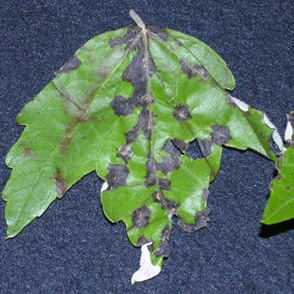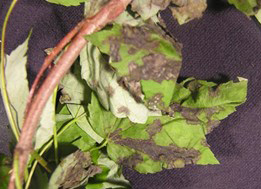Maple Anthracnose
Contact
Plant Diagnostician
Phone: (479) 575-2727
Email: ssmith@uada.edu
Jason Pavel
Diagnostician
Phone: (479) 575-7257
Email: jpavel@uada.edu
University of Arkansas System Division of Agriculture
Cralley Warren Building
Room 16
2601 N. Young Ave.
Fayetteville, AR 72704
Maple Anthracnose
Sherrie Smith and Jason Pavel
Plant Health Clinic Disease Note Issue 11

Maple Anthracnose- Gloeosporium apocryptum. (Photo by Sherrie Smith, University of Arkansas System Cooperative Extension Service)
Cool, wet weather in the spring is also favorable for outbreaks of Maple anthracnose, caused by the fungus Gloeosporium apocryptum.
Symptoms are brown to black lesions along the veins of newly opening leaves. The lesions expand and can cover large areas of the leaves. Buds, leaves, twigs, and branches up to an inch in diameter may be killed. The infected leaves fall from the tree, causing the tree to expend additional energy to re-foliate.
Yearly infections can weaken maple trees, predisposing them to other diseases and to insects.
Good sanitation is critical in anthracnose control. All fallen leaves and twigs should be raked up and removed from the planting. If the tree is small enough to make pruning practical, infected twigs should be pruned out of the canopy. A product containing chlorothalonil or mancozeb or copper may be applied at bud swell in the spring, and twice afterwards at 10–14-day intervals.
Take Aways:
- Practice good sanitation.
- Apply fungicides if practical.
- Maintain tree health with adequate water and fertilize per soil test.

Maple Anthracnose- Gloeosporium apocryptum. (Photo by Sherrie Smith, University of Arkansas System Cooperative Extension Service)
This work is supported by the Crop Protection and Pest Management Program [grant no. 2017-70006- 27279/project accession no. 1013890] from the USDA National Institute of Food and Agriculture.